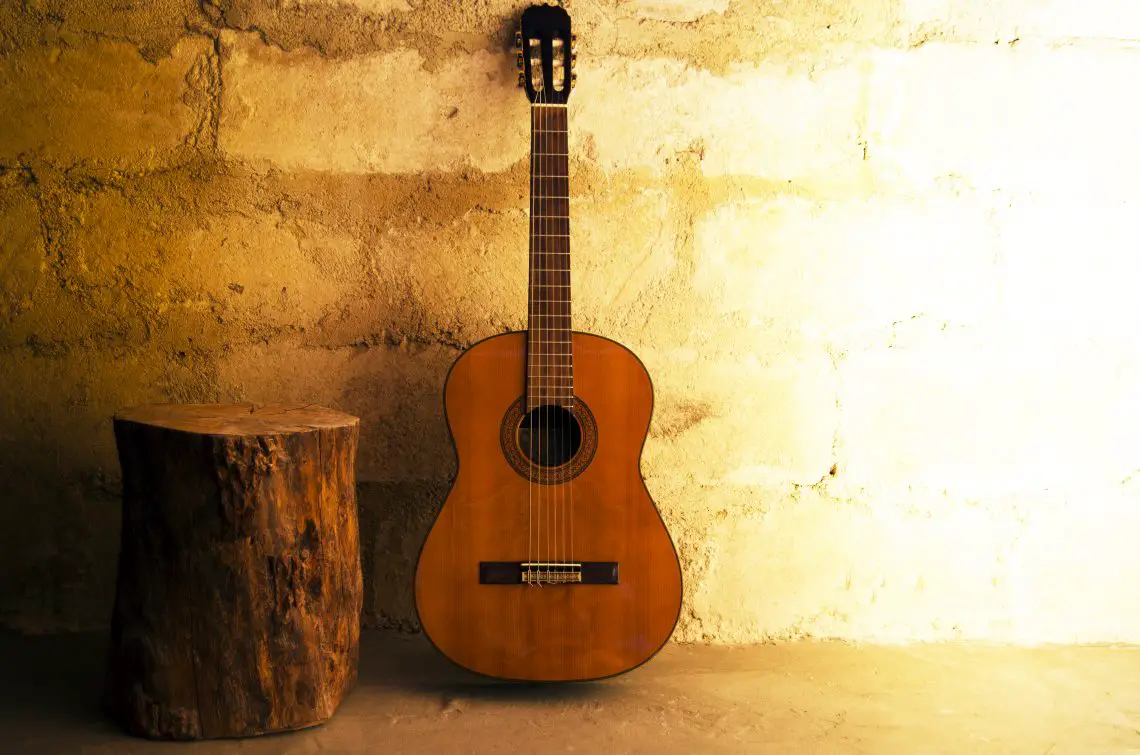Whether you are brand new to guitar and want to start on a nylon string instrument, or you’ve been playing for years and want to expand your repertoire to include classical guitar, finding the perfect classical guitar for your style and needs can be quite an undertaking.
Everyone has different inclinations toward tone, wood type, projection level, guitar styles, playing environments and aesthetics that will factor into your choice. But there are essential characteristics to look for whether you buy a beginner instrument or a high-end concert guitar.
We have spent weeks testing many classical guitar options, weighing the factors in choosing a quality instrument, and collaborating with other acoustic specialists for top recommendations.
-
 $539.99Check on Amazon Search Used
$539.99Check on Amazon Search UsedHandmade in Portugal and has the construction quality found in much higher priced guitars. The sound is well balanced, the volume output is excellent, and the design is attractive.
06/29/2025 12:05 am GMT -
 $519.99Check on Amazon Search Used
$519.99Check on Amazon Search UsedGreat choice for someone who needs to use amplification, but does not want to compromise sound quality.
03/09/2024 08:38 am GMT -
 Check on Amazon Search Used
Check on Amazon Search UsedGreat choice for a beginner to intermediate player looking to buy a classical guitar.
-
 $619.99Check on Amazon Search Used
$619.99Check on Amazon Search UsedGreat choice for beginners who do not want to spend a lot on their first guitar.
06/28/2025 09:10 pm GMT -
 Check on Amazon Search Used
Check on Amazon Search UsedBuilt-in pickup featuring a Fishman Presys Blend system, you will have lots of options to control the amplification of your playing.
-
 Check on Amazon
Check on AmazonIt has an excellent pickup system that includes a built-in USB port to use with garage band or other recording software.
-
 Check on Amazon
Check on AmazonHas a unique design with a one-of-a-kind headstock, cutaway body, and a beautiful mosaic rosette making it very appealing aesthetically.
-
 $649.70Check on Amazon Search Used
$649.70Check on Amazon Search UsedExcellent quality and even more affordable price.
06/28/2025 11:19 pm GMT -
Famous Musicians’ Use of Classical Guitars
There are many well-known musicians and artists who play classical guitar, both nylon string classical guitars and steel string acoustic guitars. Here are some examples:
Nylon string classical guitarists
- Andrés Segovia: Spanish classical guitarist widely regarded as the father of modern classical guitar.
- Julian Bream: English classical guitarist and lutenist known for his virtuosic technique and wide-ranging repertoire.
- John Williams: Australian-born British classical guitarist known for his interpretations of Bach, Spanish guitar music, and contemporary works.
- Sharon Isbin: American classical guitarist and professor at the Juilliard School, known for her innovative programming and collaborations with other musicians.
- Ana Vidovic: Croatian classical guitarist known for her expressive playing and technical skill.
- David Russell: Scottish classical guitarist known for his impeccable technique and interpretations of Spanish guitar music.
- Christopher Parkening: American classical guitarist and recording artist, known for his collaborations with composers like John Williams and André Previn.
- Pepe Romero: Spanish classical guitarist from a family of renowned guitarists, known for his interpretations of Spanish guitar music and for his work as a composer and arranger.
- Manuel Barrueco: Cuban-born American classical guitarist known for his interpretations of Spanish guitar music and contemporary works.
- Narciso Yepes: Spanish classical guitarist known for his interpretations of music by composers like Rodrigo, Albéniz, and Villa-Lobos.
Steel-string acoustic guitarists
- Tommy Emmanuel: Australian guitarist known for his fingerstyle technique and energetic performances.
- Leo Kottke: American guitarist known for his innovative fingerpicking style and his use of open tunings.
- Michael Hedges: American guitarist known for his innovative playing techniques and use of alternate tunings.
- Kaki King: American guitarist known for her percussive playing style and use of unusual tunings.
- Andy McKee: American guitarist known for his percussive fingerstyle technique and his use of alternate tunings.
- Alex de Grassi: American guitarist known for his fingerstyle technique and innovative use of harmonics.
- Don Ross: Canadian guitarist known for his fingerstyle technique and use of alternate tunings.
- Pierre Bensusan: French-Algerian guitarist known for his use of alternate tunings and his fusion of different musical styles.
- Laurence Juber: English guitarist known for his fingerstyle technique and his work as a session musician and composer.
- Chet Atkins: American guitarist known for his fingerstyle technique and his influence on country and rock guitarists.
These are just a few examples of many talented classical and acoustic guitarists who have made significant contributions to the world of music.
Classical vs. Acoustic Guitars
If you are new to guitar, it is important to make sure you pick the right type of guitar for your desired playing style. Not all acoustic guitars are the same. In fact, there are two main classes of acoustic guitars: nylon string classical guitars and steel string acoustic guitars.
It is essential that you understand the difference because they have radically different uses. If a classical guitar is played like an acoustic, you can cause severe damage.
So how can you tell a classical guitar from a steel string acoustic?
Fretboard
First, the fretboard of a classical is much wider than that of an acoustic. Most of the time a classical guitar fretboard will lack the dot or inlay fret markings along the fingerboard that are commonplace on acoustic guitars.
Body
Second, the body shape of a classical guitar tends to be very symmetrical, and it is unusual to see cutaways allowing access to higher notes (although, there are some modern classical guitars that do have a cutaway design).
Acoustic guitars are most commonly found in a significantly larger dreadnought shape with cutaway designs being a very popular choice.
Strings
Third, the biggest giveaway to whether a guitar is a classical or steel string acoustic is to look at the strings. Classical guitars are strung with nylon strings and an acoustic guitar is strung with steel strings.
If steel strings are put on a classical guitar, the higher tension will cause damage to the neck and bridge. Installing nylon strings on an acoustic guitar won’t necessarily cause damage, but it will produce a much duller sound.
Classical are also typically easier to play because the strings are easier on tender fingers (although with enough practice, any fingers will form the callouses needed for pain-free playing).
Sound
A classical guitar has a soft, mellow tone and is most often used with a fingerpicking playing style. Music styles that work well with a classical guitar are classical, folk, flamenco and other latin styles.
Acoustic guitars have a twangy, bright sound that work better with strumming and heavier finger work. Most other music styles will use a steel string acoustic as opposed to a classical guitar.
Budget
Classical guitars are popular among beginner players because they tend to be a bit cheaper to purchase than a regular acoustic. They come in a wide range of prices. You can buy a decent beginner guitar for $100-200 and can purchase an advanced guitar for $5000+.
Choosing a classical guitar depends a lot on your budget. You will want to buy the best instrument you can afford.
It can be extremely discouraging to put time into learning guitar only to produce poor-sounding music because you are playing a guitar with low tone quality. Fortunately, there are many quality and affordable guitars out there if you take the time to look.
You may want to consider buying a used or secondhand guitar. If you are on a tight budget, buying secondhand may allow you to play a higher quality instrument than if you spend the same amount of money on a new guitar.
Unfortunately, a good used guitar is going to be a lot harder to find than one that is brand new, and you’ll need to make a thorough inspection to ensure that no damage was incurred from the previous player(s). It may be a good idea to take a more experienced guitarist with you to help you catch any hidden damage.
Hand-Made vs. Factory Produced
The way a classical guitar is made will have a notable influence on the price point. Classical guitars can either be factory-made or hand-made. Guitars with a lower price point are always factory-made, meaning that they were constructed by hand in an assembly line production fashion.
Hand-made guitars are made by one guitar maker who carefully chooses woods, cuts them to size, pieces them together and finishes them. Hand-made guitars will be significantly more expensive than factory-produced.
Classical Guitar Anatomy
Understanding certain aspects of a classical guitar’s anatomy is important when searching for a quality instrument.
Soundboard
The soundboard is the top piece of wood on a classical guitar. The sound board vibrates when the strings are played, and it notably affects the resonance and sound of your music. There are two types of soundboard construction: plywood and solid wood.
Plywood soundboards are made of three thin wood layers that are all glued together. Usually, the top layer reveals a fine-grained wood while the bottom layers are of a much lower quality material.
Plywood soundboards allow for a strong and stable top, but a slightly duller sound and less resonance. Solid tops are more responsive to the vibrations of the strings and therefore create better resonance and projection.
Solid wood soundboards are assembled with two single thickness wood slabs, usually cedar or spruce, and are pieced together with a seam down the middle of the guitar. Both types of wood give different qualities to the sound of the guitar.
Spruce wood is harder and inflexible, which gives a bright, crisp sound. Cedar wood is softer, and a cedar soundboard will sound dark, mellow and warm. If you are looking for a solid top classical guitar, choose your wood based on your preferred sound.
Choose a guitar with a soundboard that has numerous, closely-spaced grains indicating older wood. Older wood soundboards vibrate easier and allow for more resonance.
Solid soundboards are always found on the highest quality (and most expensive) classical guitars. If you are on a budget, plywood soundboards still make an excellent choice for a beginner to intermediate guitar.
Body
If you are in a guitar shop and have the option to compare a few guitars side by side, it can be helpful to compare body thickness. A thicker body on a classical guitar will emphasize the lower registers whereas a thin body will emphasize the high registers.
The back and sides of a classical guitar can either be made of laminate or solid wood. This part of the guitar has less impact on the sound than the soundboard, so it is less important that this be of solid wood. Some classical guitar makers choose laminated sides because they are more stable than solid wood
Fretboards
Fretboards (a.k.a. fingerboards) are commonly constructed of Indian Rosewood on cheaper student guitars. The rosewood fingerboards are usually stained black to look more like ebony, the preferred material for higher-priced guitars.
Ebony is used on more expensive guitars because it is denser and is more resistant to wear.
Action
Take note of the guitar’s action. The string action is the span between the strings and the fretboard. A high action is more difficult to play, but can produce more sound. A low action is easier to play, but will not be able to project as much and will have more string buzz.
The goal in setting the action is to get the strings as close as possible to the fretboard while avoiding buzzing. You may need help from a more experienced guitarist the first time you set up your guitar.
Spacing
Another thing to check for on the fretboard is whether or not the strings are strung with the same spacing between them. Some guitars may have wider spacing, some may have more narrow spacing.
Whether you choose a guitar with wider or narrower spacing is up to you, but if you want a quality guitar, it is important that the strings are equally spaced.
You should also check the frets to make sure they are not sticking out too far above the neck. If the frets stick out too much, it will be uncomfortable for your fingers and may affect the sound. If your frets stick out further than you’d like, simply file them down to whatever is most comfortable for you.
Tuning
Tuning machines predominantly match the quality level of the guitar for which they were intended. They can range anywhere from a plain and lightly built apparatus to heavy duty gears.
Try to find a guitar with tuning machines that are precise and long-lasting. Make sure that the tuning nuts are working well and aren’t allowing string slippage. If your guitar is constantly going out of tune, your tuners may need to be repaired.
Pick-Up
Some classical guitars have a built-in pick-up allowing you to plug it into an amplifier. If you plan to perform often, this may be a good option for you. However, if you do not plan to perform, we recommend picking a guitar without a pick-up because it makes it more difficult for the soundboard to resonate.
If you have the opportunity, it’s a good idea to try out several different guitars to find one that has the right tones, resonance and balance for your needs. A lot of the time, the “right” sound is subjective, and you just need to find the one that is that sounds best to your ears.
Nut and Saddle
The nut and saddle are the two points on which the string is positioned on a classical guitar. On cheaper guitars, these are generally made of plastic which allows for slightly less vibration of the strings. In higher-end guitars, the nut and saddle are made of bone which is harder and more receptive to sound vibrations.
A Note on Children and Guitars
Many guitar models come in 1/2 or 3/4 size options for young students or petite adults. If you are choosing a classical guitar for a child, it would be smart to have them sit down with a couple different sized classical guitars and find the size that fits them best. A guitar should always match an individual’s height and weight distribution.
How to Care for your Classical Guitar
If keeping your classical guitar in tip-top shape is important to you, there are several actions you can take so that you can play it for the long-haul.
Lubricating the string slots in the nut will make for easier tuning and will help diminish the creaking sound that is common when tuning a classical guitar. An easy way to lubricate these slots is to color them with a graphite pencil.
Once in a while, you should clean the fretboard and buff the frets. This will prevent dirt and grime from building up and your frets from tarnishing.
To clean, use mineral oil to polish and condition the fingerboard. Mineral oil will bring filth and dampness to the surface, and it will prevent excess water from being absorbed by the wood. Here is a helpful video on how to do basic maintenance on your classical guitar and how to change the strings:
Humidity
Another aspect of guitar care is doing your best to control the humidity. A guitar should be kept at a humidity level of 40-55%. If you live in an area where the humidity fluctuates on a regular basis, it may be a good idea to look into a humidifying device to keep inside of your guitar case to help regulate the atmosphere surrounding your guitar.
If you live in an area where the humidity fluctuates on a regular basis, it may be a good idea to look into a humidifying device to keep inside of your guitar case to help regulate the atmosphere surrounding your guitar.
A digital hygrometer can be a helpful investment. Taking care to keep the proper humidity level for your classical guitar may not be as big of a priority if you are playing a lower end student guitar. If you have a higher price point classical guitar, however, keeping the humidity balanced will significantly extend the life of your guitar.
If you have a higher price point classical guitar, however, keeping the humidity balanced will significantly extend the life of your guitar.
Our Recommendation: Cordoba C7 SP Acoustic Nylon

Credit: Cordoba music group
We chose the Cordoba C7 as our top recommendation because in our opinion, it is a high-quality classical guitar at a very affordable price. The Cordoba C7 is worth every penny.
Handmade in Portugal and has the construction quality found in much higher priced guitars. The sound is well balanced, the volume output is excellent, and the design is attractive.
The Cordoba brand was mentioned more times than any other brand as a favorite among guitar specialists and players alike, and this model holds very high reviews.
This guitar offers players the choice between a solid Canadian cedar top or a solid European spruce top (click here for the link to the cedar top version).
The solid wood top and a specialized fan bracing pattern gives the instrument more projection and better tone. The back and sides are made with a beautiful Indian rosewood construction, and the whole guitar is covered with a natural high gloss finish.
The Cordoba C7 is handmade in Portugal and has the construction quality found in much higher-priced guitars. The sound is well balanced, the volume output is excellent, and it is an attractive-looking guitar.
According to reviewers, this guitar sounds better than some guitars that cost three to four times as much. This guitar is a good value, and we don’t think you’ll regret giving it a try.
Runner Up: Taylor 214ce-N Grand Auditorium

Credit: TAYLOR-LISTUG, INC
If you are a more advanced player and are looking for a higher quality guitar beyond the beginner range, the Taylor 214ce-N classical acoustic-electric guitar might be the guitar for you.
Unique and natural design aesthetic.
This guitar received high reviews from many of the acoustic professionals we talked to, and if it weren’t for the high price point, it might have been our first choice. The Taylor 214ce-N is usually priced above $1000, but it is worth the higher investment if you can afford it.
This guitar is made with a solid Sitka Spruce top with layered Indian Rosewood back and sides. It is built to work well for both fingerpick style players and strummers alike as it combines the warm, resonant tone of rosewood with the crisp projection qualities of spruce.
Classical guitars fitted with electrics are growing in demand, and the Taylor 214ce-N offers a high-end Taylor ES-N electronics system designed to amplify all the subtleties of the classical guitar style.
The design of this guitar is unique in that it is constructed with a Grand Auditorium body shape and a thinner nut width to make for an easier transition from a steel string acoustic.
If you are an experienced guitarist with a slightly higher budget and are looking for a high-quality classical guitar with electronics, this may be the perfect guitar for you.
Other Classical Guitars to Consider:
Cordoba C5 Iberia Classical Guitar

Credit: Cordoba Music Group
The Cordoba C5 Iberia classical guitar is one step down from our top pick, the Cordoba C7, but we thought it was worth listing because of it’s excellent quality and even more affordable price.
Excellent quality and even more affordable price.
A couple hundred dollars less than the C7, the Cordoba C5 offers a great opportunity for those who cannot afford the C7, but still want the quality and sound that Cordoba guitars give.
The C5 is constructed with a solid Canadian cedar top, mahogany back and sides, hand-carved headstock, fan bracing system, bone nut and saddle, and a high gloss finish giving it a warm, round sound and an attractive appearance.
This popular guitar is also available in smaller size options as well as left-handed.
Ibanez 6 String Classical Guitar

The Ibanez 6 String Classical Guitar is another great classical guitar choice. This guitar is both affordable and has excellent sound.
Has a unique design with a one-of-a-kind headstock, cutaway body, and a beautiful mosaic rosette making it very appealing aesthetically.
It boasts of a solid German spruce top, mahogany body, sides and neck, and a rosewood bridge and fingerboard. The GA3 has a unique design with a one-of-a-kind headstock, cutaway body, and a beautiful mosaic rosette making it very appealing aesthetically.
If you have the opportunity to sit down and play a few guitars before buying, we recommend giving this one a few strums to see if it is the right fit for you.
Breedlove Pursuit Acoustic-Electric Guitar

Credit: Breedlove Guitars
The Breedlove Pursuit Acoustic-Electric is a good alternative for those who want to buy a classical guitar, but want a modern design with more features.
It has an excellent pickup system that includes a built-in USB port to use with garage band or other recording software.
This classical guitar possesses a radiused fingerboard and smaller nut width than traditional classical guitars making it an easy transition from steel string acoustics.
It has an excellent pickup system that includes a built-in USB port to use with garage band or other recording software. It also sounds great without amplification with it’s Western red cedar soundboard and Sapele back and sides.
If you are an acoustic guitarist looking to get into classical guitar playing, you should look into the Breedlove Pursuit.
Cordoba Fusion Orchestra Acoustic-Electric Guitar
Cordoba also offers a great option for an acoustic guitar player looking to try out a classical guitar.
The Cordoba Fusion Orchestra Acoustic-Electric is meant to be a crossover or hybrid style of nylon string guitar. This model looks and sounds like a classical guitar, but it feels more similar to a steel string acoustic than most classical guitars.
Built-in pickup featuring a Fishman Presys Blend system, you will have lots of options to control the amplification of your playing.
It is made with a solid Canadian cedar or European spruce top, Indian rosewood back and sides, 16” radiused ebony fingerboard (this is thinner than most classical guitar fretboards), maple binding, and a beautiful high gloss finish. With a built-in pickup featuring a Fishman Presys Blend system, you will have lots of options to control the amplification of your playing. This is an excellent Cordoba guitar that is worth a try.
With a built-in pickup featuring a Fishman Presys Blend system, you will have lots of options to control the amplification of your playing. Costing between $750-800, this is an excellent Cordoba guitar that is worth a try.
Yamaha CG192S Classical Guitar
The Yamaha CG192S classical guitar is the most budget-friendly guitar we included on our list. It is a great choice for beginners who do not want to spend a lot on their first guitar but want to learn on a guitar that plays well and will give them a good experience.
Great choice for beginners who do not want to spend a lot on their first guitar.
This guitar is made with Indonesian Mahogany back and sides, a spruce top, Javanese Rosewood fretboard and bridge, and chrome tuners.
Obviously, you cannot expect the same performance out of this guitar as some of the other higher-quality guitars we have listed, but we think this is one of the best classical guitars offered at this price point.
Alvarez AC65HCE Acoustic-Electric Classical Guitar

Credit: Alvarez Guitars
Alvarez is another trusted company that produces great classical guitars. The Alvarez AC65HCE Acoustic-Electric is part of the award-winning “Artist Series”, and is a great choice for someone who needs to use amplification, but does not want to compromise sound quality.
Great choice for someone who needs to use amplification, but does not want to compromise sound quality.
This guitar is made with hand-selected solid tops (sitka spruce and cedar tops), a scalloped bracing, mahogany back and sides, and excellent craftsmanship to provide a beautiful classical tone.
The Alvarez AC65HCE is also very aesthetically beautiful with a wood mosaic and mother-of-pearl inlays. This guitar is definitely worth looking into.
Alhambra 1OP Classical Guitar

Credit: Amazon.com
Alhambra is a company based in Spain that makes excellent quality guitars. The Alhambra 1OP is another great choice for a beginner to intermediate player looking to buy a classical guitar.
Great choice for a beginner to intermediate player looking to buy a classical guitar.
This guitar features a solid red cedar top with maple binding, mahogany back and sides, and a rosewood fingerboard. It also has an open pore finish which allows the guitar to vibrate more freely.
The solid cedar top gives this classical guitar a warm yet clear sound that will only get better as the guitar ages.
Here’s a recap of our recommended guitars:
Handmade in Portugal and has the construction quality found in much higher priced guitars. The sound is well balanced, the volume output is excellent, and the design is attractive.
Great choice for someone who needs to use amplification, but does not want to compromise sound quality.
Great choice for a beginner to intermediate player looking to buy a classical guitar.
Great choice for beginners who do not want to spend a lot on their first guitar.
Built-in pickup featuring a Fishman Presys Blend system, you will have lots of options to control the amplification of your playing.
It has an excellent pickup system that includes a built-in USB port to use with garage band or other recording software.
Has a unique design with a one-of-a-kind headstock, cutaway body, and a beautiful mosaic rosette making it very appealing aesthetically.
Excellent quality and even more affordable price.
Unique and natural design aesthetic.











Start the discussion at talk.hearthemusicplay.com